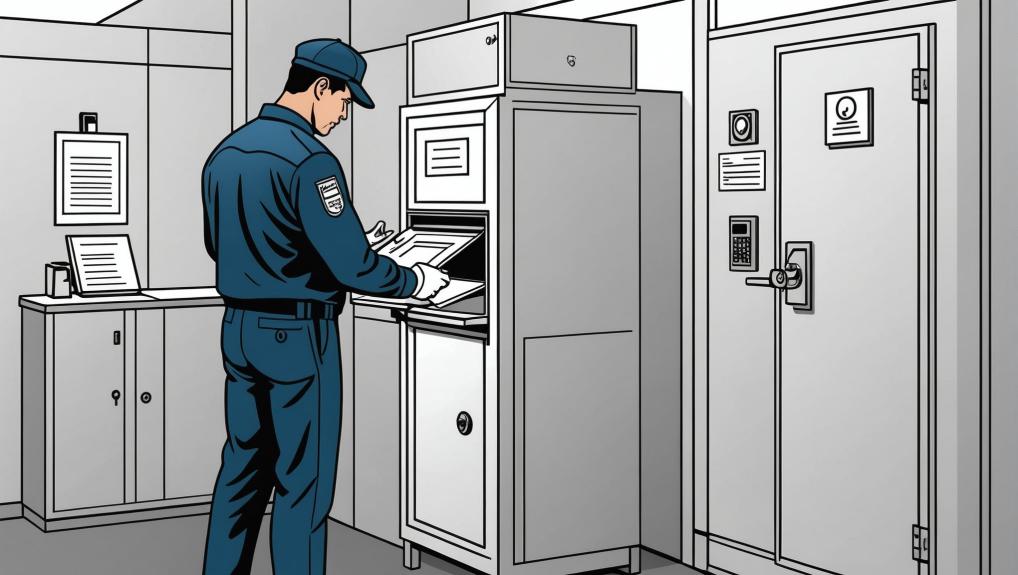When it comes to choosing between Registered Mail and Certified Mail, many find themselves uncertain, leading to stress, unnecessary costs, or even compromised security.
Both services offer proof of mailing and delivery, but they cater to different needs, each with its unique features and benefits.
In this article, we’ll break down the key differences between Registered Mail and Certified Mail. We’ll explore their security levels, tracking options, insurance coverage, and costs.
Key Takeaways:
- Security Levels: Registered Mail offers maximum security with a verifiable chain of custody, while Certified Mail provides basic tracking.
- Insurance Coverage: Registered Mail includes up to $50,000 in insurance, whereas Certified Mail requires additional purchase for limited coverage.
- Cost Differences: Certified Mail is cost-effective for important documents, while Registered Mail is pricier due to enhanced security features.
- Usage Scenarios: Use Certified Mail for routine documents needing proof of delivery; choose Registered Mail for high-value, irreplaceable items.
What is the Difference Between Registered Mail and Certified Mail?

Registered Mail and Certified Mail, both services by the United States Postal Service (USPS), provide proof of mailing and delivery but serve different purposes and offer varying levels of security and insurance.
Certified Mail is ideal for important documents needing proof of mailing and delivery. The sender gets a mailing receipt as evidence of dispatch. Upon delivery, USPS keeps the recipient’s signature on file.
For an extra fee, a return receipt, either physical or electronic, can be requested to confirm delivery. Certified Mail includes basic tracking, enabling the sender to check the item’s status online. It doesn’t, however, receive special handling or heightened security and is generally more affordable.
Registered Mail, on the other hand, offers the highest level of security available through USPS. It ensures a verifiable chain of custody with detailed records of each USPS employee who handles the item.
Registered Mail also includes insurance coverage up to $50,000, making it suitable for high-value items. This service provides more detailed tracking updates throughout the shipping process, ensuring greater security and accountability.
What Makes Certified Mail Different from Registered Mail?
Certified Mail and Registered Mail differ primarily in security, tracking, and cost.
Certified Mail provides proof of mailing and requires a signature upon delivery. It’s ideal for sending important but replaceable documents, like tax forms and legal notices.
Though it includes basic tracking, it doesn’t offer insurance, making it a cost-effective choice for less valuable items.
Registered Mail, on the other hand, is designed for high-value or irreplaceable items. It offers enhanced security, including a verifiable chain of custody where each USPS employee handling the item is logged.
Registered Mail is stored in locked containers or safes when not in transit, ensuring maximum protection. It also offers detailed tracking updates throughout the shipping process and includes insurance coverage up to $50,000 for loss or damage, contributing to its higher cost.
Choosing between these services depends on the value and importance of the mail, as well as the level of security and tracking detail you need.
When Should I Use Certified Mail Instead of Registered Mail?

Use Certified Mail when you need proof of delivery but don’t require extensive security or insurance. This service is ideal for sending important documents like legal notices, tax forms, and insurance claims that need confirmation of receipt but lack high intrinsic value.
Certified Mail is cost-effective, making it suitable for routine business correspondence such as invoices and statements.
It’s also a practical choice for personal documents that need delivery confirmation without the added expense of high-security measures. This affordability is a key benefit for both individuals and businesses seeking reliable mailing services without incurring unnecessary costs.
One essential feature of Certified Mail is the USPS tracking number, which lets senders monitor the mail’s status. This basic tracking and delivery confirmation are usually sufficient for sensitive, but not highly valuable, documents.
Certified Mail is also suitable for deliveries to PO boxes, where recipients must sign for the mail, ensuring it reaches the intended person. This balance of proof of delivery and cost-effectiveness makes Certified Mail versatile for various mailing needs.
How Does the Cost of Certified Mail Compare with Registered Mail?
Certified Mail is significantly cheaper than Registered Mail, reflecting differences in security and insurance.
Certified Mail, meant for important documents needing proof of mailing and delivery, is a cost-effective option. The base fee is $4.85.
Additional services, like a physical return receipt, cost $4.10, and an electronic return receipt is $2.62. Including First-Class postage, the total ranges from $5.80 to $9.64, depending on the chosen services.
Registered Mail, on the other hand, starts at $18.60 due to its heightened security measures and insurance coverage, which can go up to $50,000. This higher base fee includes these protections, making Registered Mail ideal for valuable or irreplaceable items requiring maximum security and precise tracking.
Both services cater to specific needs: Certified Mail for cost-effective proof of delivery, and Registered Mail for high-value items needing superior security. The choice between them should align with the sender’s requirements and the value of the contents being mailed.
What Security Features Does Registered Mail Offer That Certified Mail Doesn’t?

Registered Mail offers several security features that Certified Mail doesn’t, ensuring more robust protection for valuable items.
First, Registered Mail provides a verifiable chain of custody. Every USPS employee who handles the registered item must sign for it, creating a detailed record from acceptance to delivery and ensuring accountability at every step.
Second, Registered Mail benefits from locked storage. Items are kept in secure containers, safes, or cages when not in transit, reducing the risk of unauthorized access, theft, or loss. Additionally, tamper-evident seals or tape are often used, making any unauthorized attempts to access the contents easily detectable.
Third, Registered Mail offers higher insurance coverage, which can go up to $50,000 based on the declared value of the item. In contrast, Certified Mail doesn’t include insurance by default.
Finally, Registered Mail has restricted delivery options, ensuring that only the named addressee or an authorized agent can receive the mailpiece.
These combined features make Registered Mail a superior choice for sending valuable or sensitive items safely and securely.
How Do Delivery Times Differ Between Certified and Registered Mail?
Certified Mail and Registered Mail, both services offered by the United States Postal Service (USPS), differ in delivery times due to their distinct security and handling protocols.
Certified Mail:
- First-Class Mail: Typically delivered within 2 to 5 business days.
Certified Mail prioritizes proof of mailing and delivery but doesn’t involve extensive security measures, making it faster.
Registered Mail:
- First-Class Mail: Usually takes about 2 to 5 business days.
Despite similar delivery estimates, Registered Mail’s elaborate security protocols, including detailed tracking and secure handling, often extend the overall delivery time.
What Are the Insurance Options for Registered Mail Versus Certified Mail?

Certified Mail, offered by USPS, doesn’t include insurance by default. It’s mainly for providing proof of mailing and delivery for important documents, which usually don’t need high-value insurance.
If you want insurance for items sent via Certified Mail, you can buy additional coverage up to $5,000. The cost starts at $2.50, based on the declared value.
Registered Mail, on the other hand, comes with insurance as part of the service. USPS insures Registered Mail up to $50,000, depending on the declared value.
This service also includes enhanced security measures like locked storage and a verifiable chain of custody to protect items during transit.
Which is better registered or Certified Mail?
Choosing between Certified Mail and Registered Mail hinges on your specific needs for security, tracking, insurance, and cost.
Certified Mail is more cost-effective and provides proof of delivery through a mailing receipt and the recipient’s signature. It includes a unique tracking number for online status monitoring.
However, it lacks the extensive security features of Registered Mail, making it less suitable for highly valuable items.
Registered Mail offers the highest level of security, including locked storage, tamper-evident seals, and a verifiable chain of custody.
It provides thorough tracking updates at each mailing stage and offers insurance coverage up to $50,000, based on the item’s declared value. The trade-off is a higher cost and potentially longer delivery times due to the added security measures.
Ultimately, the choice between Certified Mail and Registered Mail depends on what you’re sending and the level of security and insurance you need.
For cost-effective mailing with basic proof of delivery, Certified Mail is ideal. For maximum security and insurance, go with Registered Mail.
What is the safest way to send important documents?

To send important documents securely, using Registered Mail through the United States Postal Service (USPS) is the safest option.
This service ensures a detailed chain of custody, requiring each USPS employee handling the mail to sign for it. This guarantees accountability at every step.
Registered Mail also features electronic tracking and secure storage in locked containers, minimizing the risk of loss or theft. Additionally, Registered Mail includes tamper-evident seals, making any unauthorized access attempts easily detectable.
It offers insurance coverage up to $50,000 based on the declared value of the item, providing financial protection for valuable items.
The service also includes restricted delivery options, ensuring that only the named addressee or an authorized agent can receive the mailpiece.
Certified Mail, another USPS service, is suitable for important documents needing proof of mailing and delivery but lacks the extensive security features of Registered Mail.
While Certified Mail provides a mailing receipt, recipient’s signature upon delivery, and basic tracking, it is handled as standard mail without locked storage or a detailed chain of custody.
Insurance coverage up to $5,000 is available but must be purchased separately.
Frequently Asked Questions
How Do I Track My Registered or Certified Mail?
To track your registered or certified mail, use the unique tracking number given at the time of mailing. Enter this number on the postal service’s official website for real-time updates and status. You can also contact customer service for assistance.
For example, if you’ve mailed a package via USPS, enter your tracking number on the USPS website or call their customer service. This way, you can monitor the location and delivery status of your mail.
Can Both Certified and Registered Mail Be Sent Internationally?
Yes, you can send both certified and registered mail internationally. The availability of these services, however, differs by country. For detailed information on international mailing options, check with your local postal service.
What Happens if Registered or Certified Mail Gets Lost?
If registered or certified mail gets lost, the sender can file a claim with the postal service for potential reimbursement. Registered mail offers higher insurance coverage than certified mail, providing greater protection for valuable items.
Do Both Services Require a Signature Upon Delivery?
Certified Mail requires a signature for receipt confirmation. Registered Mail, on the other hand, provides enhanced security and tracking with the option for a signature. Both services offer different levels of accountability and security, tailored to the needs of the sender.
Conclusion
Registered Mail and Certified Mail cater to different needs, offering varied levels of security and insurance.
Certified Mail is designed for important but replaceable documents, providing proof of mailing and delivery along with basic tracking. It’s ideal for legal documents, contracts, or other critical paperwork where delivery confirmation is necessary.
Registered Mail, on the other hand, is suited for high-value or irreplaceable items, such as jewelry, collectibles, or sensitive data. It offers enhanced security measures, detailed tracking throughout the delivery process, and higher insurance coverage.
This makes it the go-to option for shipments requiring maximum protection and accountability.
Understanding these distinctions helps in choosing the right mailing service, ensuring the safe and secure delivery of your items.

